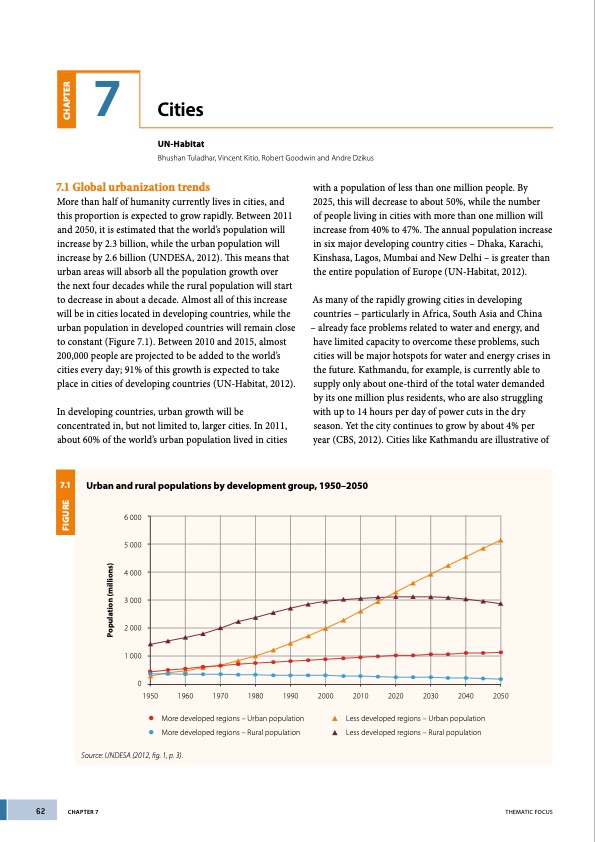
PDF Publication Title:
Text from PDF Page: 078
7 Cities UN-Habitat Bhushan Tuladhar, Vincent Kitio, Robert Goodwin and Andre Dzikus 7.1 Global urbanization trends More than half of humanity currently lives in cities, and this proportion is expected to grow rapidly. Between 2011 and 2050, it is estimated that the world’s population will increase by 2.3 billion, while the urban population will increase by 2.6 billion (UNDESA, 2012). This means that urban areas will absorb all the population growth over the next four decades while the rural population will start to decrease in about a decade. Almost all of this increase will be in cities located in developing countries, while the urban population in developed countries will remain close to constant (Figure 7.1). Between 2010 and 2015, almost 200,000 people are projected to be added to the world’s cities every day; 91% of this growth is expected to take place in cities of developing countries (UN-Habitat, 2012). In developing countries, urban growth will be concentrated in, but not limited to, larger cities. In 2011, about 60% of the world’s urban population lived in cities with a population of less than one million people. By 2025, this will decrease to about 50%, while the number of people living in cities with more than one million will increase from 40% to 47%. The annual population increase in six major developing country cities – Dhaka, Karachi, Kinshasa, Lagos, Mumbai and New Delhi – is greater than the entire population of Europe (UN-Habitat, 2012). As many of the rapidly growing cities in developing countries – particularly in Africa, South Asia and China – already face problems related to water and energy, and have limited capacity to overcome these problems, such cities will be major hotspots for water and energy crises in the future. Kathmandu, for example, is currently able to supply only about one-third of the total water demanded by its one million plus residents, who are also struggling with up to 14 hours per day of power cuts in the dry season. Yet the city continues to grow by about 4% per year (CBS, 2012). Cities like Kathmandu are illustrative of 7.1 Urban and rural populations by development group, 1950–2050 6 000 5 000 4 000 3 000 2 000 1 000 0 Source: UNDESA (2012, fig. 1, p. 3). 1950 1960 1970 1980 1990 2000 2010 2020 2030 2040 2050 More developed regions – Urban population More developed regions – Rural population Less developed regions – Urban population Less developed regions – Rural population 62 CHAPTER 7 THEMATIC FOCUS Population (millions) FIGURE CHAPTERPDF Image | Water and Energy

PDF Search Title:
Water and EnergyOriginal File Name Searched:
225741e.pdfDIY PDF Search: Google It | Yahoo | Bing
NFT (Non Fungible Token): Buy our tech, design, development or system NFT and become part of our tech NFT network... More Info
IT XR Project Redstone NFT Available for Sale: NFT for high tech turbine design with one part 3D printed counter-rotating energy turbine. Be part of the future with this NFT. Can be bought and sold but only one design NFT exists. Royalties go to the developer (Infinity) to keep enhancing design and applications... More Info
Infinity Turbine IT XR Project Redstone Design: NFT for sale... NFT for high tech turbine design with one part 3D printed counter-rotating energy turbine. Includes all rights to this turbine design, including license for Fluid Handling Block I and II for the turbine assembly and housing. The NFT includes the blueprints (cad/cam), revenue streams, and all future development of the IT XR Project Redstone... More Info
Infinity Turbine ROT Radial Outflow Turbine 24 Design and Worldwide Rights: NFT for sale... NFT for the ROT 24 energy turbine. Be part of the future with this NFT. This design can be bought and sold but only one design NFT exists. You may manufacture the unit, or get the revenues from its sale from Infinity Turbine. Royalties go to the developer (Infinity) to keep enhancing design and applications... More Info
Infinity Supercritical CO2 10 Liter Extractor Design and Worldwide Rights: The Infinity Supercritical 10L CO2 extractor is for botanical oil extraction, which is rich in terpenes and can produce shelf ready full spectrum oil. With over 5 years of development, this industry leader mature extractor machine has been sold since 2015 and is part of many profitable businesses. The process can also be used for electrowinning, e-waste recycling, and lithium battery recycling, gold mining electronic wastes, precious metals. CO2 can also be used in a reverse fuel cell with nafion to make a gas-to-liquids fuel, such as methanol, ethanol and butanol or ethylene. Supercritical CO2 has also been used for treating nafion to make it more effective catalyst. This NFT is for the purchase of worldwide rights which includes the design. More Info
NFT (Non Fungible Token): Buy our tech, design, development or system NFT and become part of our tech NFT network... More Info
Infinity Turbine Products: Special for this month, any plans are $10,000 for complete Cad/Cam blueprints. License is for one build. Try before you buy a production license. May pay by Bitcoin or other Crypto. Products Page... More Info
| CONTACT TEL: 608-238-6001 Email: greg@infinityturbine.com | RSS | AMP |